




Your support is critical to our success.
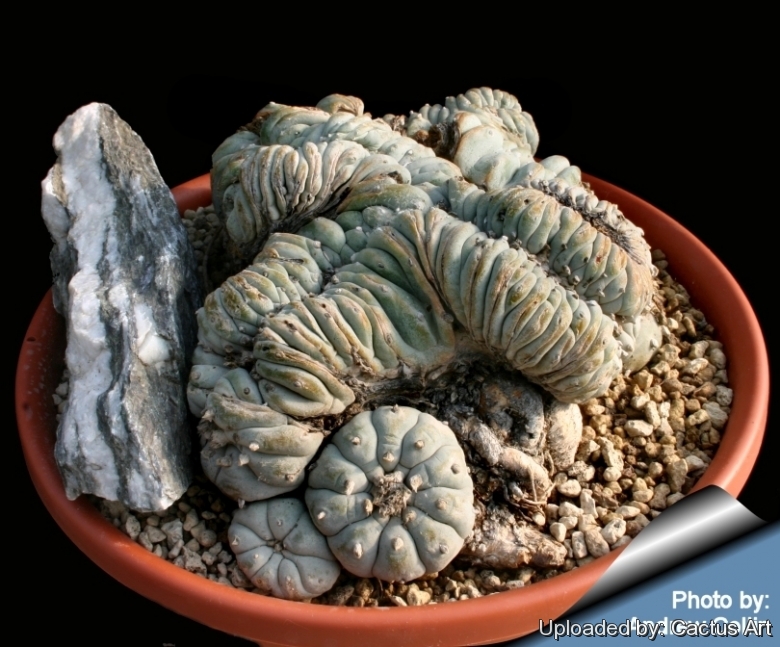
Lophophora sp. (williamsii?) forma cristata. Photo and © copyright by Andrew Collin (Texas, USA) Sometime a crested palnt produce some normal shoots. Which are not monstrous at all! But all this very different forms are the same plant! They are epigenetic variation not genetic mutant!
Origin and Habitat: Garden origin (Nursery produced cultivar) and habitat (Mexico)
Synonyms:
- Lophophora williamsii var. cristata Houghton
Lophophora williamsii var. cristata Houghton
J. Cact. Succ. Soc. Amer. 2: 490. 1931
Accepted name in llifle Database:
Lophophora williamsii (Lem. ex Salm-Dyck) J.M.Coult.
Contr. U.S. Natl. Herb. 3: 131. 1894
Synonymy: 34
- Lophophora williamsii (Lem. ex Salm-Dyck) J.M.Coult.
- Anhalonium visnagra K.Schum.
- Anhalonium williamsii (Salm-Dyck) Rümpler
- Anhalonium williamsii Lem. ex Förster
- Ariocarpus williamsii (Salm-Dyck) Voss
- Echinocactus lewinii (Henn. ex Lewin) K.Schum. in Engl. & Prantl
- Echinocactus williamsii Lem. ex Salm-Dyck
- Echinocactus williamsii var. anhaloninicus K.Schum.
- Echinocactus williamsii var. pellotinicus (K.Schum.) Rouhier
- Mammillaria williamsii (Lem.) J.M.Coult.
- Lophophora williamsii var. echinata (Croizat) Bravo
- Lophophora echinata Croizat
- Lophophora williamsii var. fricii f. cristata hort.
- Lophophora williamsii var. fricii f. variegata hort.
- Lophophora williamsii subs. grymi Halda, J.Kupčák & Sladk.
- Lophophora williamsii var. heptagona Y.Itô
- Lophophora williamsii var. jourdaniana (Haberm.) hort.
- Anhalonium jourdanianum Lewin
- Echinocactus jourdanianus Rebut ex C.A.Maass
- Lophophora jourdaniana Haberm.
- Lophophora williamsii var. lewinii (Henn. ex Lewin) J.M.Coult.
- Anhalonium lewinii Henn. ex Lewin
- Lophophora lewinii (Henn.) Rusby
- Mammillaria lewinii (Henn. ex Lewin) H.Karst.
- Lophophora williamsii var. pentagona Croizat
- Lophophora pentagona (Croizat) V.Gapon
- Lophophora williamsii var. pluricostata Croizat
- Lophophora pluricostata (Croizat) V.Gapon
- Lophophora williamsii var. texana Frič ex Kreuz.
- Lophophora lutea var. texana (Frič ex Kreuz.) Backeb.
- Lophophora williamsii var. typica Croizat
Lophophora williamsii var. caespitosa Y.Itô
1952 (nom. inval)
Accepted name in llifle Database:
Lophophora williamsii var. caespitosa f. variegata hort.
Accepted name in llifle Database:
Lophophora williamsii var. fricii (Haberm.) Grym
Rod Lophophora 56 1997
Synonymy: 8
- Lophophora williamsii var. fricii (Haberm.) Grym
- Anhalonium floro rosea Frič
- Lophophora diffusa subs. fricii (Haberm.) Halda
- Lophophora fricii Haberm.
- Peyotl zacatensis (Haberm.) Sotom., Arred. & Mart.Mend.
- Peyotl zacatensis var. fricii (Haberm.) Sotom., Arred. & Mart.Mend.
- Lophophora fricii var. decipiens (Croizat) P.Hansen
Lophophora williamsii f. variegata hort.
Cultivars (2):
ENGLISH: Crested Peyote, Crested Lophophora
Description: The Lophophoras are famous spineless cacti commonly known as "Peyote". The stem is often glaucous green, dull bluish or greyish green, very succulent, globular, top-shaped, or somewhat flattened with a woolly top. There are several different species, variety and forms (plus some intermediates and hybrid populations) In addition to the foregoing there exists an impressive array of cristates which forms nicely contorted and convoluted brain-like mounds. They are some of the more striking and priced crested cacti. They shows different crested shapes each of them has its own particular fascination.
Remarks: The long time known L. williamsii 'Cristata' is the more common and famous, but more recently cristates of segregate species have been illustrated and given Japanese names by Sato (1999).
Subspecies, varieties, forms and cultivars of plants belonging to the Lophophora williamsii group
 Lophophora fricii var. decipiens (Croizat) P.Hansen: With the exception of the smaller and more pale pink flowers, its appearance corresponds to the appearance of Lophophora Fricii.
Lophophora fricii var. decipiens (Croizat) P.Hansen: With the exception of the smaller and more pale pink flowers, its appearance corresponds to the appearance of Lophophora Fricii. Lophophora williamsii (Lem. ex Salm-Dyck) J.M.Coult.: Globular or somewhat flattened glaucous green or greyish green spineless cactus up to 6 cm tall, 12 cm diameter, with a woolly top; It has a large taproot which may extend over 25 cm below ground level.
Lophophora williamsii (Lem. ex Salm-Dyck) J.M.Coult.: Globular or somewhat flattened glaucous green or greyish green spineless cactus up to 6 cm tall, 12 cm diameter, with a woolly top; It has a large taproot which may extend over 25 cm below ground level. Lophophora williamsii var. caespitosa Y.Itô: This name is used to indicate a number of clones of horticultural origin characterized by a more or less accentuated production of axillary shoots that in age grow and form huge cushions.
Lophophora williamsii var. caespitosa Y.Itô: This name is used to indicate a number of clones of horticultural origin characterized by a more or less accentuated production of axillary shoots that in age grow and form huge cushions. Lophophora williamsii var. caespitosa f. variegata hort.: variegated form.
Lophophora williamsii var. caespitosa f. variegata hort.: variegated form. Lophophora williamsii var. cristata Houghton: There is an impressive array of cristates which forms glaucous green, dull bluish or greyish green, very succulent contorted and convoluted brain-like mounds. They are some of the more striking and priced crested cacti.
Lophophora williamsii var. cristata Houghton: There is an impressive array of cristates which forms glaucous green, dull bluish or greyish green, very succulent contorted and convoluted brain-like mounds. They are some of the more striking and priced crested cacti.- Lophophora williamsii var. echinata (Croizat) Bravo
 Lophophora williamsii var. fricii (Haberm.) Grym: Beautiful variety with large intensive pink pink flowers.
Lophophora williamsii var. fricii (Haberm.) Grym: Beautiful variety with large intensive pink pink flowers. Lophophora williamsii var. fricii f. cristata hort.: crested form.
Lophophora williamsii var. fricii f. cristata hort.: crested form. Lophophora williamsii var. fricii f. variegata hort.
Lophophora williamsii var. fricii f. variegata hort. Lophophora williamsii var. fricii cv. Marbles: has wide and well developed rounded tubercles. Seems to be a pretty variable plant with several clones.
Lophophora williamsii var. fricii cv. Marbles: has wide and well developed rounded tubercles. Seems to be a pretty variable plant with several clones.- Lophophora williamsii subs. grymi Halda, J.Kupčák & Sladk.: Solitary or in group with 6-10 prominent straight ribs with low polygonal tubercles with short brownish wool. Flowers large pinkish-white.
 Lophophora williamsii var. jourdaniana (Haberm.) hort.: It has rose-violet or dark pink-red perianth, pistil and filaments with small long persisting spines on young areoles. Old plant forms a dense cluster or mound.
Lophophora williamsii var. jourdaniana (Haberm.) hort.: It has rose-violet or dark pink-red perianth, pistil and filaments with small long persisting spines on young areoles. Old plant forms a dense cluster or mound.- Lophophora williamsii var. lewinii (Henn. ex Lewin) J.M.Coult.: Long areolar hairs.
- Lophophora williamsii var. pentagona Croizat: All heads 5-ribbed.
- Lophophora williamsii var. pluricostata Croizat: Ribs always numerous.
 Lophophora williamsii var. texana Frič ex Kreuz.: (or texensis ) is the phenotype from the Texas area (USA), this local form has very grey pruinose stems with numerous flat ribs (up to 14 in adult specimens).
Lophophora williamsii var. texana Frič ex Kreuz.: (or texensis ) is the phenotype from the Texas area (USA), this local form has very grey pruinose stems with numerous flat ribs (up to 14 in adult specimens). Lophophora williamsii cv. Kikko: This odd cultivar is easily distinguishable for its ± wide and long pointed tubercles along the bumped ribs edges. Seems to be a pretty variable plant with several clones.
Lophophora williamsii cv. Kikko: This odd cultivar is easily distinguishable for its ± wide and long pointed tubercles along the bumped ribs edges. Seems to be a pretty variable plant with several clones.
Bibliography: Major references and further lectures
1) Terry, M. 2013. Lophophora williamsii. In: IUCN 2013. IUCN Red List of Threatened Species. Version 2013.2. <www.iucnredlist.org>. Downloaded on 24 February 2014.
2) Edward Anderson “The Cactus family” Timber Press, Incorporated, 2001
3) James Cullen, Sabina G. Knees, H. Suzanne Cubey "The European Garden Flora Flowering Plants: A Manual for the Identification of Plants Cultivated in Europe, Both Out-of-Doors and Under Glass" Cambridge University Press, 11/Aug/2011
4) David R Hunt; Nigel P Taylor; Graham Charles; International Cactaceae Systematics Group. "The New Cactus Lexicon" dh books, 2006
5) Edward F. Anderson “Peyote: The Divine Cactus” University of Arizona Press, 1996
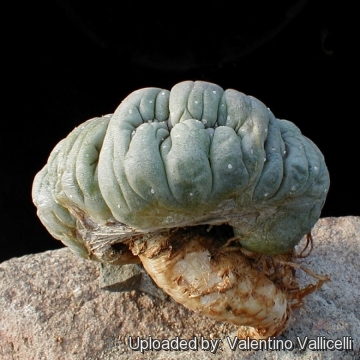
Lophophora williamsii var. cristata Photo by: Valentino Vallicelli
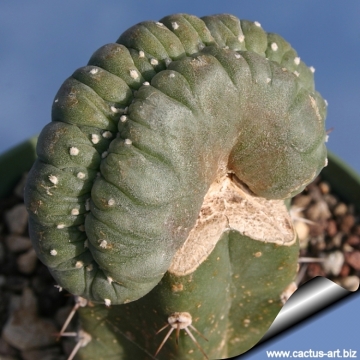
Lophophora williamsii var. cristata Photo by: Cactus Art
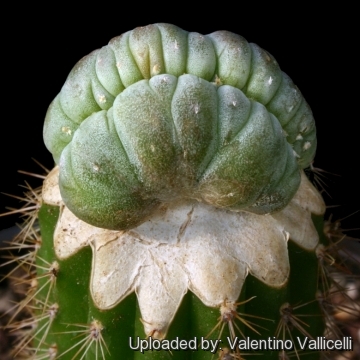
Lophophora williamsii var. cristata Photo by: Valentino Vallicelli
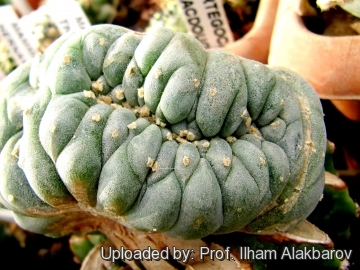
Lophophora williamsii var. cristata Photo by: Prof. Ilham Alakbarov
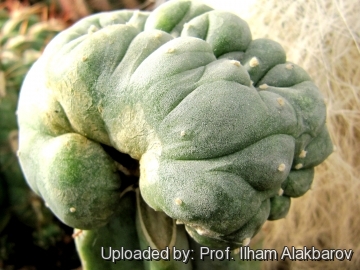
Lophophora williamsii var. cristata Photo by: Prof. Ilham Alakbarov
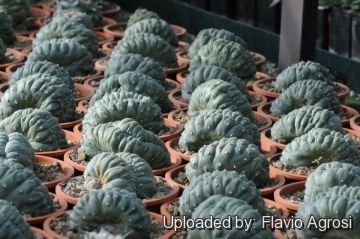
Lophophora williamsii var. cristata Photo by: Flavio Agrosi
Cultivation and Propagation: All Lophophora species are extremely slow growing, often taking up to thirty years to reach flowering age in the wild (about the size of a golf ball, not including its root). Human cultivated specimens grow considerably faster, usually taking from six to ten years to go from seedling to mature flowering adult.
Soil: Because of the tap root they are very rot prone, so use highly gritty compost with much drainage.
Exposure: Requires half shade to part sun.
Moisture: Waterings should be rather infrequent to keep the plant compact and not to become excessively elongated and unnatural in appearance, watering it properly is often difficult because this plant tends to crack open or rot if over-watered. The fact that the plant retracts into the soil and assume a grey-green colouring between watering, is perfectly natural and doesn’t cause any damage.
Overwatering: Keep completely dry and cool in winter (An unheated greenhouse would be perfect) or when night temperatures remain below 10° C, it can survive low temperatures (appr. -7°C) for a short period. Assure a good ventilation.
Specific tips for growing the crested forms: The crests are frequently grafted onto columnar cacti but are easily grown on their own roots. Any normal shoots should be removed to promote the growth of the crest.
Propagation: Grafting or cuttings in summer (Cuttings will root only in hot weather. Cuttings must be kept very dry to root). The sowing of seeds collected on crested specimen give occasionally raise to some crested plants, but whit a very low frequency. The seeds requiring hot and humid conditions to germinate.
| Your Actions | |
|---|---|
| Back to Lophophora index | |
| Back to Cactaceae index | |
 |
Back to Cacti Encyclopedia index |
Privacy stantement - Terms and conditions - How to cite - About us - Feedback - Donate




